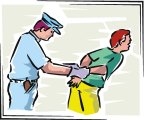
Worksheets and No Prep Teaching Resources
Reading Comprehension Worksheets
Crime and Terrorism

Crime and Terrorism
 Worksheets and No Prep Teaching Resources Reading Comprehension Worksheets Crime and Terrorism |
 Crime and Terrorism |
| edHelper's suggested reading level: | grades 9 to 12 | |
| Flesch-Kincaid grade level: | 8.14 |
| Print Finding Yourself After Identity Theft (font options, pick words for additional puzzles, and more) |
| Quickly print reading comprehension |
| Print a proofreading activity |
|
Finding Yourself After Identity Theft
By Colleen Messina |

|
 1 Finding oneself can be a lifelong process, but it becomes an urgent matter if you have experienced identity theft. Identity theft is when people use your name or personal information without your permission for unlawful economic gain. They might steal your social security number, your driver's license number, or your credit card number and use them to open new accounts in your name. Then, they make major purchases without your knowledge. You end up with large bills and large headaches!
1 Finding oneself can be a lifelong process, but it becomes an urgent matter if you have experienced identity theft. Identity theft is when people use your name or personal information without your permission for unlawful economic gain. They might steal your social security number, your driver's license number, or your credit card number and use them to open new accounts in your name. Then, they make major purchases without your knowledge. You end up with large bills and large headaches! |
Create Weekly Reading Books
Prepare for an entire week at once! |
| Leave your feedback on Finding Yourself After Identity Theft (use this link if you found an error in the story) |
 |
Crime and Terrorism
|
 |
High School Reading Comprehensions and High School Reading Lessons
|
 |
Social Studies
|